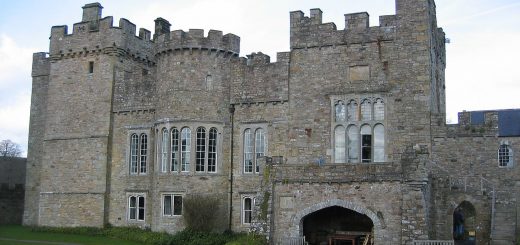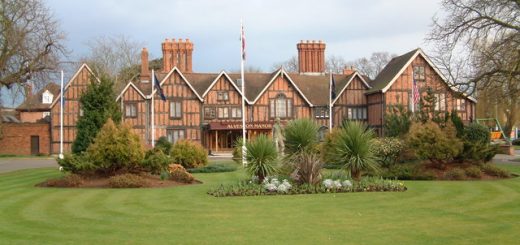The Grey Man of Ben Macdhui
Ben Macdhui is the second highest peak in Scotland, a huge mountain with deep corries, situated in the Cairngorms: one of Scotland’s finest mountain ranges, and a magnet for walkers, climbers and other outdoor enthusiasts. Ben Machdhui is also reputed to be haunted by ‘something’ that is popularly known as the Grey Man or Fear Liath Mhor in Gaelic.
Strange experiences have been recorded on the mountain from at least the turn of the twentieth century. Various witness sightings and experiences have amalgamated into a popular image of a huge ape-like misty figure that has the malign power to send people into a blind panic. In an attempt – as some writers have speculated – to push them over the steep cliffs of Lurcher’s crag.
Witness Experiences on Ben Macdhui
The Fear Liath Mhor first came to general public attention when the respected mountaineer Professor Norman Collie addressed the Annual General Meeting of the Cairngorm club in 1925. His experience dated from 1891 when he was climbing the mountain alone. I have reproduced it in full.
 “I was returning from a cairn on the summit in the mist when I began to think I heard something else other than my own footsteps. For every few steps I took I heard a crunch and then another crunch as if someone was walking after me but taking footsteps three or four times the length of my own. I said to myself this is all nonsense. I listened and heard it again but could see nothing in the mist. As I walked on and the eerie crunch, crunch sounded behind me I was seized with terror and took to my heels staggering blindly among the boulders for four or five miles nearly down to Rothiemurchus Forest. Whatever you make of it I do not know but there is something very queer at the top of Ben Macdhui and I will not go there again by myself I know.”
“I was returning from a cairn on the summit in the mist when I began to think I heard something else other than my own footsteps. For every few steps I took I heard a crunch and then another crunch as if someone was walking after me but taking footsteps three or four times the length of my own. I said to myself this is all nonsense. I listened and heard it again but could see nothing in the mist. As I walked on and the eerie crunch, crunch sounded behind me I was seized with terror and took to my heels staggering blindly among the boulders for four or five miles nearly down to Rothiemurchus Forest. Whatever you make of it I do not know but there is something very queer at the top of Ben Macdhui and I will not go there again by myself I know.”
This is the first recorded encounter of the Grey Man (although the Brocken effect was noted earlier, see Explanations) and caused something of a sensation at the time, creating a lot of interest in the mountain and its possible other-world denizen. It is interesting to note that Cameron McNeish, the respected outdoor author and walker, has noted that Norman Collie was a well known practical joker. He would certainly have been amused by all the publicity that has been generated by the story.
A second hand account exists that the mountaineer Henry Kellas, and his brother witnessed a giant figure on the mountain around the turn of the 20th Century, which caused them to flee down Corrie Etchachan. This has never been verified as Henry Kellas died on the Everest reconnaissance mission of 1921, before Norman Collie’s speech to the Cairngorm Club.
In 1945 a climber called Peter Densham reported hearing footsteps and fleeing the mountain in panic. Peter was part of the team that was responsible for aeroplane rescue in the Cairngorms during the war.
Another experience on the mountain by Alexander Tewnion – Naturalist and Mountaineer -appeared in ‘The Scots Magazine’, in June 1958. It took place in 1943 when he was climbing Ben Macdhui armed with a loaded revolver in search of game for the pot (perhaps naturalist was stretching it a bit). He was returning from the mountain by the Corrie Etchachnan track in fear of getting caught in a storm, here is his account of the event:
“I am not unduly imaginative, but my thought flew instantly to the well known story of professor Collie and the Fear Liath Mhor. Then I felt the reassuring weight of the loaded revolver in my pocket. Grasping the butt, I peered about in the mist here rent and tattered by the eddies of wind. A strange shape loomed up, receded, came charging at me! Without hesitation I whipped out the revolver and fired three times at the figure. When it still came on I turned and hared down the path, reaching Glen Derry in a time that I have never bettered. You may ask was it really the Fear Laith Mhor? Frankly I think it was. Many times since then I have traversed MacDhui in the mist, bivouacked out in the open, camped on its summit for days on end on different occasions – often alone, and always with an easy mind. For on that day I am convinced I shot the only Fear Liath Mhor my imagination will ever see.” Fortunately for Alexander the figure that he filled with lead was intangible and not a lost tourist, this account does show that by 1958 the Fear Liath Mhor had become part of the popular culture of the mountain.
Another witness encounter involved a friend of the author Richard Frere, who wished to remain anonymous. He was camping on top of the mountain when he saw a large brown creature swaggering away down the mountainside in the moonlight. He estimated the size of the figure at around twenty feet tall. Author Wendy Wood heard footsteps following her in the vicinity of the mountain, after hearing Gaelic music, and there have been other reports of phenomena on the mountain, from ghostly music, feelings of panic to the discovery of huge footprints in the 1940’s.
Explanations?
There have been many explanations for the Grey Man phenomena, but looking at the experiences as a whole there are actually very few sightings of a ‘Grey Man’ most accounts are associated with feeling rather than actual physical sightings, even these sightings do not agree: A huge grey mist like figure, a great brown creature 20 feet tall, and a dark human shaped figure.
Some people have put forward the theory that a wild-man or yeti type creature inhabits the area. I think we can safely dismiss this, I have met some wild men from the area, but they were much less hairy than the average yeti and more inclined to be propping up a bar in the wee hours than roaming the cairngorm plateaux scaring the wits out of hapless tourists. Besides explaining a mystery with another mystery is never a good option.
A more reasonable explanation for some of the sightings of huge figures in the mist could be phenomena known as the Brocken spectre, named after the German mountains where the effect was first discovered. An early account of such an event occurs in ‘In the Shadow of Cairngorm’ by The Rev. W. Forsyth,
‘Sir Thomas Dick Lauder describes such an appearance (“Edinburgh New Philosophic Journal, 1831.”) “On descending from the top (of Ben Mac Dhui) at about half-past three P.M., an interesting optical appearance presented itself to our view. We had turned towards the east, and the sun shone on our backs, when we saw a very bright rainbow described on the mist before us. The bow, of beautifully distinct prismatic colours, formed about two-thirds of a circle, the extremities of which appeared to rest on the lower portion of the mountain. In the centre of this incomplete circle there was described a luminous disc, surrounded by the prismatic colours displayed in concentric rings. On the disc itself, each of the party (three in number), as they stood about fifty yards apart, saw his own figure most distinctly delineated, although those of the other two were invisible to him. The representation appeared of the natural size, and the outline of the whole person of the spectator was most correctly portrayed. To prove that the shadow seen by each individual was that of himself, we resorted to various gestures, such as waving our hats, flapping our plaids, &c., all which motions were exactly followed by the airy figure.’
This account shows that the Brocken effect, where shadows are reflected onto mist banks giving the appearance of huge figures, has occurred on Ben Machdhui.
An interesting explanation for the sound of following footsteps was put forward some years ago, and appeared in the popular Trail magazine. It was suggested that the sound could be caused by freezing action upon footprints recently created in snow. We would first have to presume that the encounter in 1891, and other witness testimonies of footsteps, took place in the appropriate conditions.
The most common factor that links the experiences on the mountain is the feeling of blind panic that the witnesses feel. Some researchers have named such experiences ‘Mountain Panic’ which is basically a blind panic in wild places. Either as a feeling of a powerful presence, or just an overwhelming sense of fear about nature or something that lies behind nature. This kind of encounter is not uncommon: Chris Townsend the respected long distance walker and author mentions such an experience in ‘The Munro’s and the Tops’. In Glen Strathfarrar on a track by the Allt Innis a’Mhuill. Chris had an overwhelming feeling of a presence watching him, waiting for him to leave. Rennie McOwan mentions a similar experience in his ‘Magic Mountains’, and I have heard first hand accounts of similar experiences in wild places. The mechanisms behind this are not at all clear. Some witnesses felt that it was a power behind nature itself, usually hostile (unsurprising given man’s track record), and have felt compelled to get away from the area as quickly as possible. When this occurs all the rationality in the word cannot stem the depth of feeling involved. In classical times these experiences were identified with the nature god Pan, who lends his name to the word Pan-ic itself. Whether these experiences are a combination of location, solitude and unfamiliarity, or an actual physical effect is unclear.
In folklore there is a whole denizen of nasties wandering the wilderness perhaps old explanations for the feeling people felt and experienced in the wild areas. From the hideous Nuckelavee, and the Each Uisge, to the Headless Trunk of the MacDonalds, Folklore has a virtual who’s who of things you would not like to meet down a dark valley.
Ben Machdui is a marvellous mountain in a stunning and prestigious wild area, whether haunted or not the mountain will hopefully remain an unspoiled wild part of Scotland into the future. Personally I believe the Grey Man to be modern Folklore, perhaps relating to older legends, a belief I will repeat in my mind if I ever hear slow thunderous footsteps behind me in the Lairig Ghru.




Recent Comments